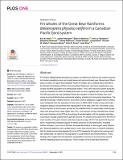Fin whales of the Great Bear Rainforest : Balaenoptera physalus velifera in a Canadian Pacific fjord system
Abstract
Fin whales (Balaenoptera physalus) are widely considered an offshore and oceanic species, but certain populations also use coastal areas and semi-enclosed seas. Based upon fifteen years of study, we report that Canadian Pacific fin whales (B. p. velifera) have returned to the Kitimat Fjord System (KFS) in the Great Bear Rainforest, and have established a seasonally resident population in its intracoastal waters. This is the only fjord system along this coast or elsewhere in which fin whales are known to occur regularly with strong site fidelity. The KFS was also the only Canadian Pacific fjord system in which fin whales were commonly found and killed during commercial whaling, pointing to its long-term importance. Traditional knowledge, whaling records, and citizen science databases suggest that fin whales were extirpated from this area prior to their return in 2005-2006. Visual surveys and mark-recapture analysis documented their repopulation of the area, with 100-120 whales using the fjord system in recent years, as well as the establishment of a seasonally resident population with annual return rates higher than 70%. Line transect surveys identified the central and outer channels of the KFS as the primary fin whale habitat, with the greatest densities occurring in Squally Channel and Caamano Sound. Fin whales were observed in the KFS in most months of the year. Vessel- and shore-based surveys (27,311 km and 6,572 hours of effort, respectively) indicated regular fin whale presence (2,542 detections), including mother-calf pairs, from June to October and peak abundance in late August-early September. Seasonal patterns were variable year-to-year, and several lines of evidence indicated that fin whales arrived and departed from the KFS repeatedly throughout the summer and fall. Additionally, we report on the population's social network and morphometrics. These findings offer insights into the dynamics of population recovery in an area where several marine shipping projects are proposed. The fin whales of the Great Bear Rainforest represent a rare exception to general patterns in this species' natural history, and we highlight the importance of their conservation.
Citation
Keen , E M , Pilkington , J , O'Mahony , E , Thompson , K-L , Hendricks , B , Robinson , N , Dundas , A , Nichol , L , Alidina , H M , Meuter , H , Picard , C R & Wray , J 2021 , ' Fin whales of the Great Bear Rainforest : Balaenoptera physalus velifera in a Canadian Pacific fjord system ' , PLoS ONE , vol. 16 , no. 9 , 0256815 . https://doi.org/10.1371/journal.pone.0256815
Publication
PLoS ONE
Status
Peer reviewed
ISSN
1932-6203Type
Journal article
Description
Funding: This research was supported by a Mitacs Accelerate Internship (IT21479); the Save Our Seas Foundation; Willow Grove Foundation; Donner Canadian Foundation; Tides Canada; LUSH Charity Pot; private donations to North Coast Cetacean Society; Fisheries and Oceans Canada; and the Canada Nature Fund for Aquatic Species at Risk (CANAFSAR 2019-2021).Collections
Items in the St Andrews Research Repository are protected by copyright, with all rights reserved, unless otherwise indicated.

